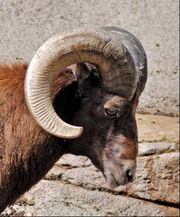
34. Mating Systems and Parental Care

A male bighorn sheep. The large horns are used in combat between males during mating season, and likely evolved as a result of intrasexual selection. © 2012 Nature Education Photo courtesy of Michael D. Breed. All rights reserved.
A mating system is how organisms sexual behavior is displayed and maintained such as:
Monogamy: a pair that mates and breeds with one another for life.
Seasonal Monogamy: a pair that mates and breeds with one another for the breeding season.
Polygny: one male mating with several females.
Polyandry: one female mating with several males.
Promiscuity: when any one male mates with any one female of the same species
(Shuster & Wade, 2003).
Mating systems essentially focus on how an organism chooses a mate. Each species chooses a mate differently, as each species has different costs and benefits associated with mating.
One of the most important elements of understanding mating systems is understanding how many mates an organism will have in its life. Bateman's principle exists to help make predictions about mating success as well as potential number of mates for an organism. The prinicple assumes that variance among females is low while variance among males is high. The reason for this, according to Kransec et al, is that one mating is generally enough to allow for the fertilization of all a females eggs, while success for males depends on how many times they get to mate (Kransec et al 2012). This results in more females successfully mating than males in a population. This can be viewed as high reprodctive output for females, and relatively low reproductive output for males within a population (Bateman 1948). Because of this, one can also assume that sexual selection acts more strongly on males than it does on females. This can be viewed when considering the cost that many males accrue in relation to mating.
The male peacock is an excellent example of this cost. They must take the time and energy to grow elaborate tail feathers. This makes them more easily seen by predators, plus the fact that they are unable to move as quickly as a bird without the same plumage. These drawbacks confused Darwin, as he could not see a positive side to having the large, cumbersome tail feathers. The reason these exist, however, is because females will only mate with males with large tails; thus the large tail will be passed on.
In a simliar vein, mate choice is also important when considering mating systems. Traditionally females are the choosier sex. They will look for size, coloration, strength, plumage, vocalizations, territorial advantages, and many other things when choosing a mate. The female can generally afford to be picky, as she has the most to lose from a mating. It is her that will spend the time and energy on the offspring, even if the species does not care for its young.
Bibliography:
WIP
Krasnec, M., Cook, C., & Breed, M. (2012). Mating Systems in Sexual Animals. Nature Education Knowledge, 3(10), 72.